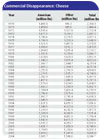
Super Bowl Sunday is a super day for cheese; then again, almost everyday seems to be a very good day to eat cheese.
Retailers stock up on cheese and run major promotions for a week or two ahead of Super Sunday. Pizzerias also gear up for the big day and numerous chains say Super Sunday is, indeed super-the best single day of sales all year long.

Cheeseburgers and pizzas played a big role in helping Americans gain a better appreciation of cheeses and now both-cheeseburgers and pizzas-are popping up on menu boards in almost every country on the planet. Cheese-fried rice, anyone?
Here in the U.S., the best USDA disappearance data we have shows that cheese sales have grown year after year after year. Commercial disappearance data are based on:
- production;
- imports;
- exports; and
- changes in inventory levels.
I looked back 35 years and here's what I found. During 28 of the 35 years, the commercial disappearance of cheese increased 2 percentage points or more when compared to the previous year. During 14 of those years, usage increased 5% or more. The year 1975 saw a modest decline: -0.3%.
Between 1970 and 2004, the commercial disappearance of cheese more than quadrupled by growing from 2.308 billion lbs to 9.346 billion lbs annually. This is a track record that gives others in the food business a real case of sales envy.
Obviously, population growth helps push total cheese usage higher, yet, the per capita consumption data re-enforce the everyday-all-day usage story. During 1970, each man, woman and child (on average) chowed down on 11.37 lbs of cheese. By 2004, per capita consumption had nearly tripled by growing to 31.24 lbs, according to USDA.
We aren't just eating more cheese; we are eating better cheese, natural cheese. About 40% of the cheese that Americans consumed in 1970 was processed product. Today, that number has shrunk to less than 20%.
Much of the growth in natural cheese consumption may be traced straight back to the pizza business, but use reaches well beyond the pie. More and more cheeseburgers are being adorned with a nice slice of provolone or Swiss, some crumbled blue or gorgonzola.
The cheeseburger was joined by the grilled chicken breast; add a slice or two of cheese. The cheeseburger joints' new neighbor is a sub shop. No neighborhood is complete with an Italian restaurant or two. Deli sandwiches-most with slices of cheese-are showing up on more and more menus.
There's much more to the story, but you get the picture. Cheese sales have been scoring touchdowns for a long, long time and not just on Super Bowl Sunday.